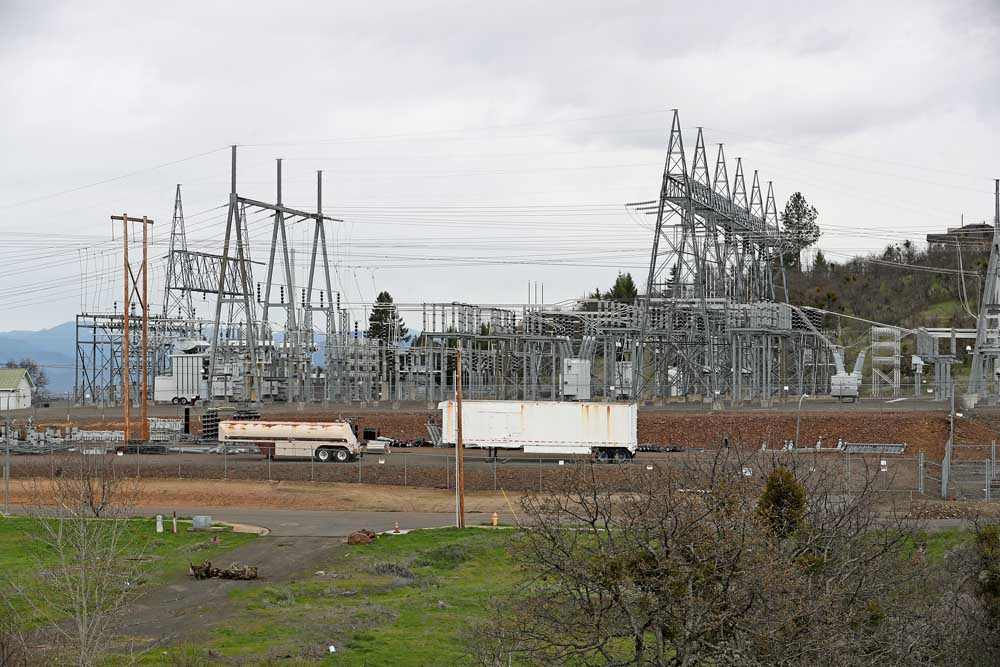Pacific Power eyes 11.5-mile transmission line from Medford to White City
Published 4:30 pm Wednesday, February 7, 2024

- Pacific Power is proposing to build a 230-kilovolt transmission line from this substation on Lone Pine Road just east of Medford to another substation in the White City area near Medford's wastewater treatment plant. The line would follow Foothill Road and Highway 140 and would, in part, provide backup power if needed.
Pacific Power has drafted a plan to build an 11.5-mile-long electrical transmission line from northeast Medford to northwest White City along a route that follows major roads, including Foothill Road and Highway 140.
The company previously considered a more westerly route that would have generally followed Sampson and Whetstone creeks and impacted more homes. At least 40 people, including homeowners, have commented on the plan, mostly concerning the western route.
“The westside route fell out, ever so slightly, it fell out as the least impactful,” John Anielio, Pacific Power project manager, told the Jackson County Board of Commissioners on Jan. 23, the same day that the company held an open house attended by about 25 people at the Roxy Ann Grange.
The 230-kilovolt line, known as the Lone Pine to Whetstone line, would stretch from a substation on Lone Pine Road just outside the Medford city limits and go north along Foothill Road before turning west along Highway 140 and snaking through White City to the Whetstone Creek substation, across Kirkland Road from the Medford wastewater treatment plant. Along the way, the line would skirt the edge of the state of Oregon’s Ken Denman Wildlife Area.
Ninety percent of the line would be new, including about 100 new monopoles as tall as 105 feet, with a span of line about 600 feet between poles. The project’s cost is an estimated $16 million to $18 million. Underground lines would cost about 10 times more, according to Anielio.
The purpose of the line is to provide greater service reliability and backup: If one line becomes unusable, now there will be an alternative. The line, which in reality is three lines on the same pole, is not the smallest or largest capacity of lines in common use, but a mid-range. Capacities typically range from 69 to 500 kilovolts.
Figuring into the company’s choice of route was the ability to locate on already existing power poles in already developed areas, according to Anielio’s presentation. Other considerations included scenic views, riparian areas and the presence of protected wildlife and habitat.
Concerns from the public include the impact on views, wildlife and property values, as well as concerns about wildfire and health risks. Anielio said “there’s no proven documented health risk” from transmission lines.
Pacific Power is pursuing a certificate of public necessity from the Oregon Public Utility Commission, in case the company needs to seek condemnation of property to make way for the line.
“We’re actually pursuing the permissions to condemn,” Anielio said. “We have to have that kind of in our toolbox to get some reluctant landowners to agree to right-of-ways, but, hopefully, through negotiation … we can put poles that are in places that are least bothersome to them.”
County staff will decide whether to issue permits for the project, with decisions appealable to a hearings officer. The company expects to apply in March or April, with a decision expected by the end of August. Construction would start next year.
Regarding possible wildfires sparked by downed or arching lines, Anielio said protocols have changed, making it more likely that power could be shut off as a precaution, such as during periods of hot temperatures and high winds.
“What it’s going to lead to is a lot of power outages on purpose,” he said.
A company wildfire mitigation plan updated in December addresses fire prevention, fire suppression and weather issues. For each project, the company models wildfire risk.
“We have a weather department in the company now,” Anielio said. “That’s how serious they’re taking the threat.”
Both steel and wood poles will be used for the project, with wood poles protected from fire using a protective wrap that reaches 8 feet high. The company expects to trim nearby trees, which otherwise could fall and impact lines.
“We’re much more aggressively keeping the right-of-ways clean, so you’ll see a lot more tree pruning permit requests,” Anielio said.
In a related matter, another transmission line proposed from Grants Pass to the Whetstone substation is currently going through a permitting process involving the Oregon Department of Energy.
More information is available from Anielio at 503-545-9539 or Jackson County Development Services, 541-774-6900.





